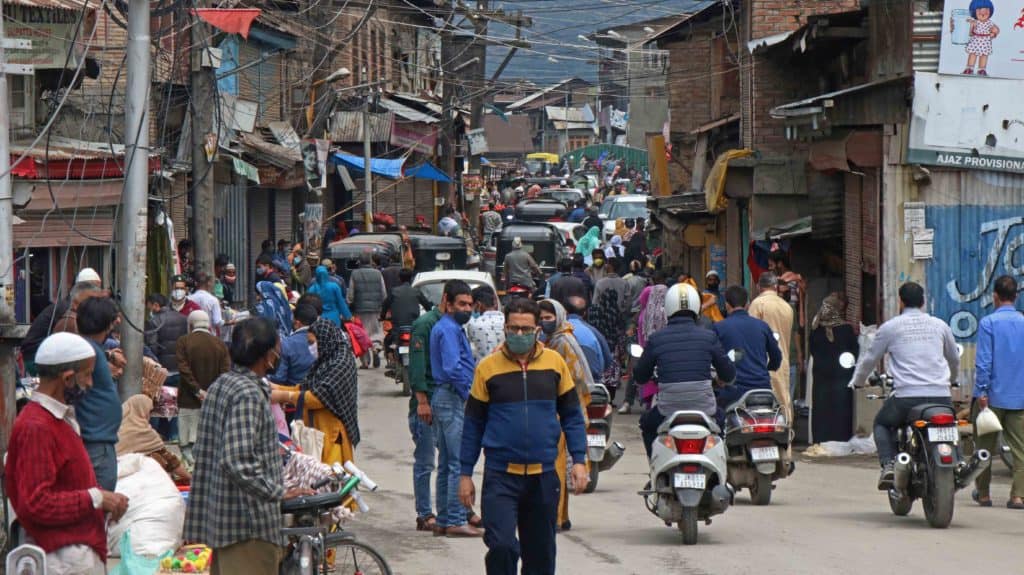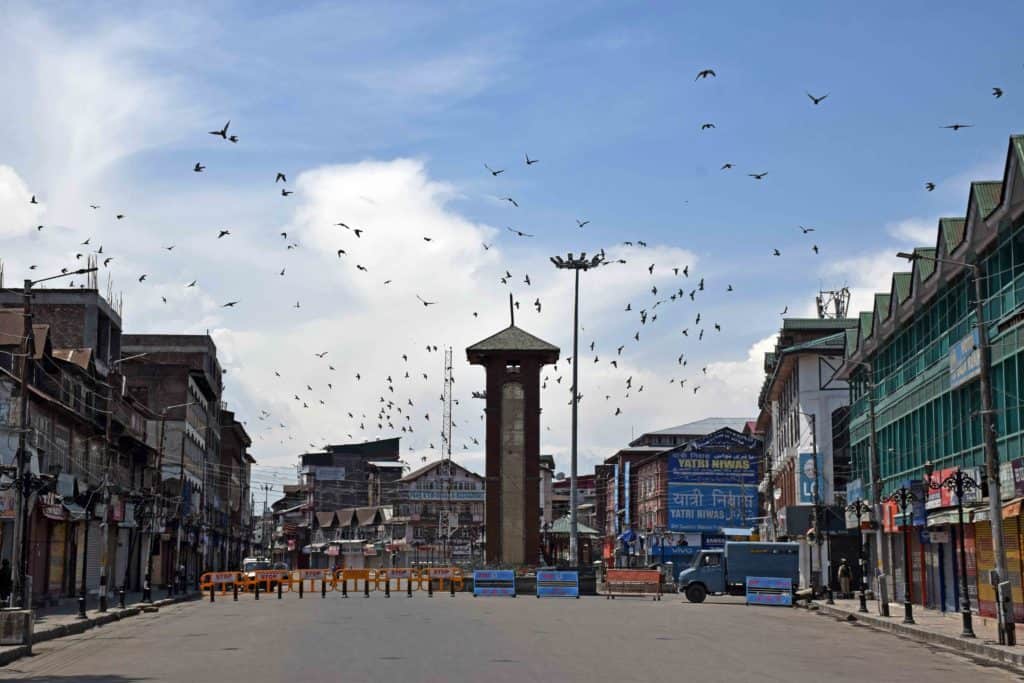When the rest of the country was grappling with the highly virulent COVID second wave in March-April, the Jammu and Kashmir government was busy with preparations to host a mega-Tulip festival at Asia’s largest Tulip garden in Srinagar. Scheduled for six days starting April 3rd, thousands of local residents, tourists and officials thronged the garden on the inaugural day.
The event was jointly inaugurated by J&K Lieutenant Governor Manoj Sinha and Kerala Governor Arif Muhammad Khan. Prime Minister Narendera Modi was the festival’s brand ambassador. Prior to the official inauguration, Modi had tweeted: “……..The garden will see over 15 lakh flowers of more than 64 varieties in bloom.”
Thousands of people from various districts flooded the Tulip garden from April 4th to 12th. Long queues were seen outside the main entry gate of the garden with children, elderly people and women throwing all COVID-appropriate behaviour to the wind.
The Tulip festival took place exactly a month after the J&K government had hosted the second edition of Khelo-India festival at the ski-resort of Gulmarg, where over 1000 athletes from across the country participated. Almost all athletes reached Srinagar to have a Shikara ride before leaving for their home states.

The adverse impact of all this overcrowding in Srinagar didn’t take long to be felt. Data available with the UT’s health department suggested that 3,867 people were infected by the virus in the first week of April in Jammu and Kashmir. The valley alone saw 2,755 cases of which, 1,347 were reported in Srinagar district. The surge in positive cases became steep in April. From 461 daily cases in the UT on April 1st, the count reached a six-month high of 812 cases on April 7th, with the numbers rising daily without any respite till date.
Read more: Srinagar: COVID-19, two deaths, 45 positive cases and counting…
The deadly double mutation
On an average, Srinagar recorded 800 to 1000 cases till April 29th, forcing the district administration to announce a first phase of lockdown till May 3rd, that was later extended till May 17th. Between May 3rd and May 12th, Srinagar averaged 800-900 positive cases per day. The mortality rate also witnessed a spike. Figures available with Citizen Matters show that from May 1st-15th, an average of 50 to 60 deaths were reported, mostly from Srinagar and Jammu districts. Total deaths crossed the 3100 figure in the UT. Till May 19th, Srinagar district recorded 701 COVID deaths, the highest among all districts.
On May 10th, the Srinagar administration issued an order allowing sale of essential items including mutton, chicken, milk, and vegetables from 8 am to 12 noon. The result was chaos, as Eid-ul-Fitr was just three days away. It was madness on Srinagar roads with people rushing to bakeries and mutton shops. Srinagar’s residents are voracious mutton-eaters and Eid has for several decades been celebrated with the cooking of three to four mutton dishes in every home, besides a variety of sweets, bakery and confectionary items.
But not this year. As pictures of people flooding markets to beat the ‘Corona Curfew’ went viral on social media, deputy Commissioner Srinagar withdrew the order and banned the sale of “permissible items.” But the damage was done.

On the eve of Eid (May 13th and 14th) very few tests were done, as people stayed indoors. Many health experts then had posted the same message on social media pages: “Results of pre-Eid street madness will show results a week after Eid”. They were right.
As of May 15th, Srinagar had 58,030 total positive cases. On May 16th, Srinagar reported 831 fresh positive cases including five tourists. As per 2011 Census, Srinagar population was recorded at 1.2 million, now estimated at 1.5 million, causing fears that the actual numbers are likely to be much higher that what is being reported.
Dr. Shashi Sudhan Sharma, Principal and Dean, Government Medical College (GMC), Jammu, said the double mutation known as B.1.617 is responsible for the surge in COVID cases in J&K. “The department of microbiology at GMC, besides testing COVID-19 samples, is also coordinating with NCDC New Delhi for routine sequencing of positive samples; as per the latest report received from them, the UK variant was reported in over 60% samples in March,” said Dr Sharma. “This variant of SARS COV-2 has been observed to originate from a specific geographic location and was able to move to other locations of the globe.”
Read more: In Srinagar, houseboats and their builders face extinction
No ban on tourist arrivals
Yet, despite the big COVID spike in Kashmir, especially Srinagar, there has been no ban on tourist arrivals in Srinagar despite the lockdown being extended to May 24, though they were far fewer in number than earlier. Figures accessed by Citizen Matters suggest that from January to April 30th, 1,26,076 tourists including 424 foreigners arrived in Srinagar. April alone recorded 32,520 tourist arrivals, including of 74 foreigners.
Director, Tourism of Kashmir, G N Itoo said that as of now there is no government order for stopping tourists from coming to Kashmir. “The arrivals have gone down though,” said Itoo. “Not more than 15 to 20 tourists are coming to Kashmir on daily basis.” How the tourists are spending the day is unclear, as all gardens and parks in Srinagar and elsewhere are closed.

Tariq Ahmed, who owns Sea Place House Boat in Dal Lake, Srinagar said tourism has received a major jolt for the second consecutive year. “In almost over 600 houseboats in Dal Lake, there are not more than ten tourists at present,” said Tariq. “I received two women tourists from Russia on May 19th. The stayed in the houseboat for a night and then left for Pahalgam early morning on May 20”.
“Kashmir is a beautiful and calm place,” said Galina, one of the Russian tourists staying at Tariq’s houseboat. “We never miss a chance to visit this place every year. We are taking all precautions to prevent COVID spread. We were tested for COVID at Srinagar airport and our reports came as negative. So, we are in Kashmir for a week or more.”
Read more: Growing vegetables, storing rice: Lessons from Srinagar that has seen and survived many lockdowns
Hospital beds: 100 per cent occupancy
Srinagar has four major COVID-19 designated hospitals: Shere-e-Kashmir Institute of Medical Science-Soura, Jawhar Lal Nehru Memorial Hospital, Chest Diseases Hospital and the city’s main hospital, Shri Maharaja Hari Singh Hospital (SMSH). “There are over 100 beds at Chest Diseases hospital and almost all are occupied,” said Dr Naved Nazir, head of department at the Chest Diseases hospital. “There is no dearth of oxygen in our hospital but the number of patients coming for admission has increased, which is not a good sign. I once again urge people to follow COVID-appropriate behaviour to prevent further spread of the virus”.
Dr Nisarul Hassan, Associate Professor at Government Medical College (GMC) Srinagar, said that admission of people with COVID symptoms has increased manifold at the city’s main hospital, SMHS. “Last year, five to ten patients would arrive with mild symptoms of bilateral pneumonia but now the situation is worse,” said Dr Hassan. “Now we receive 35 to 40 a day, all of whom have bilateral pneumonia. What is worrisome is that all of them need oxygen support which shows how serious the situation is. Kashmir reports 25 to 30 deaths on an average and 10 to 15 are from Srinagar district alone.”
Covid numbers (new cases) in Srinagar
May 10th – 19th
May 10: 701 cases
May 11: 846 cases
May 12: 863 cases
May 13: 872 cases
May 14: 379 cases
May 15: 404 cases
May 16: 831 cases
May 17: 495 cases
May 18: 666 cases
May 19: 675 cases
Vaccine shortage
On May 16th, not a single person was vaccinated in Srinagar as Kashmir witnessed shortage of both Covishield and Covaxin vaccines, while 9000 people were vaccinated on this day in Jammu region.
Srinagar residents have taken to social media to express their anger over the shortage of vaccines. “After waiting in a long queue outside a Primary Health Centre for three hours to get vaccinated, I was told there is no vaccine,” said Aijaz Ahmed, a resident of Batamaloo area of Srinagar. “Hundreds of people had to return without taking a jab.” People of Srinagar are questioning why vaccines are available in Jammu and not in Srinagar.
Data available says that in the past four days, 40,000 doses of vaccines were administered to people in Jammu but in Kashmir division, only 818 jabs were given. In Srinagar, less than 100 people were vaccinated in during May 12th-16th, as vaccines were not available at a majority of the designated health centres.
As of now, there is no indication that the vaccine shortage will end any time soon.